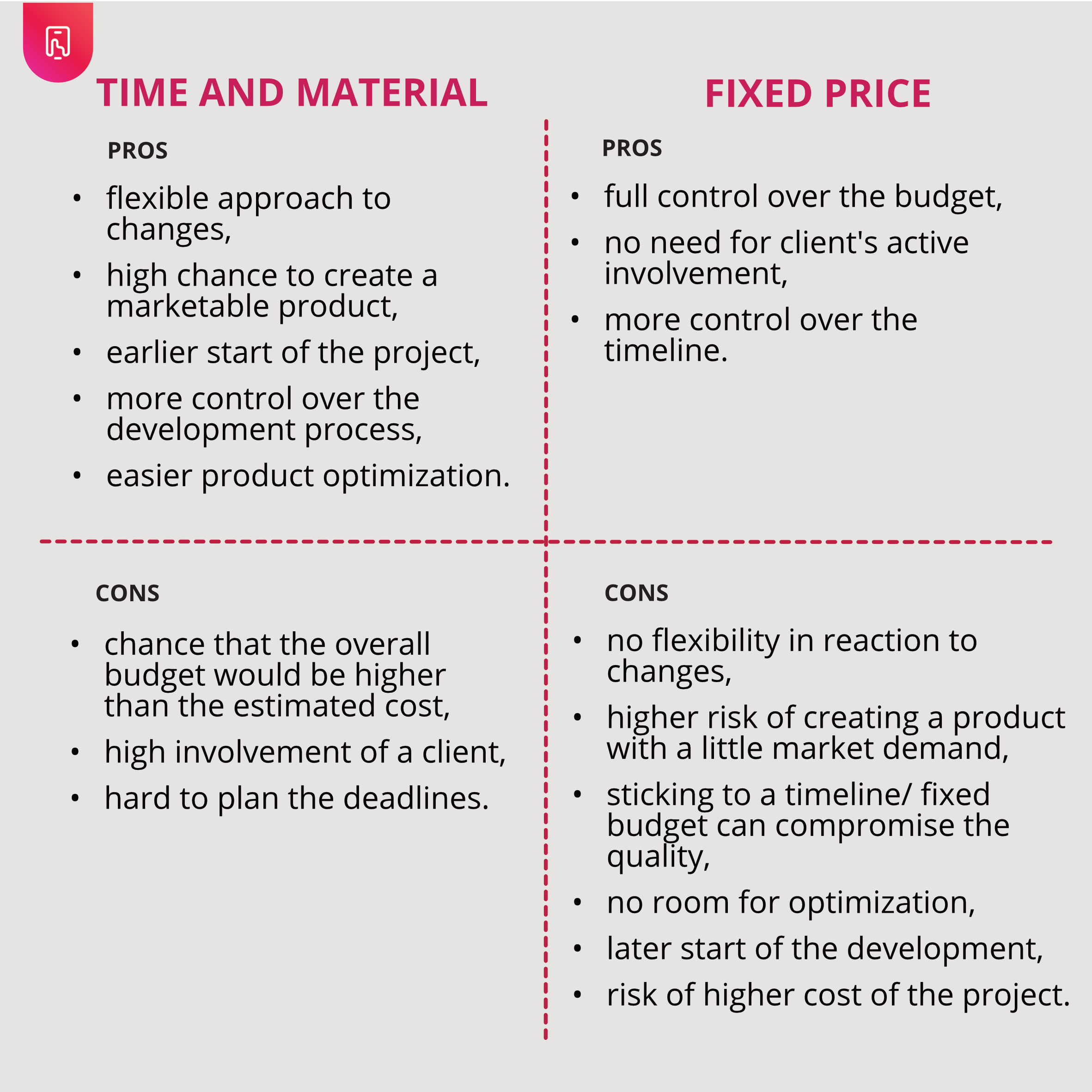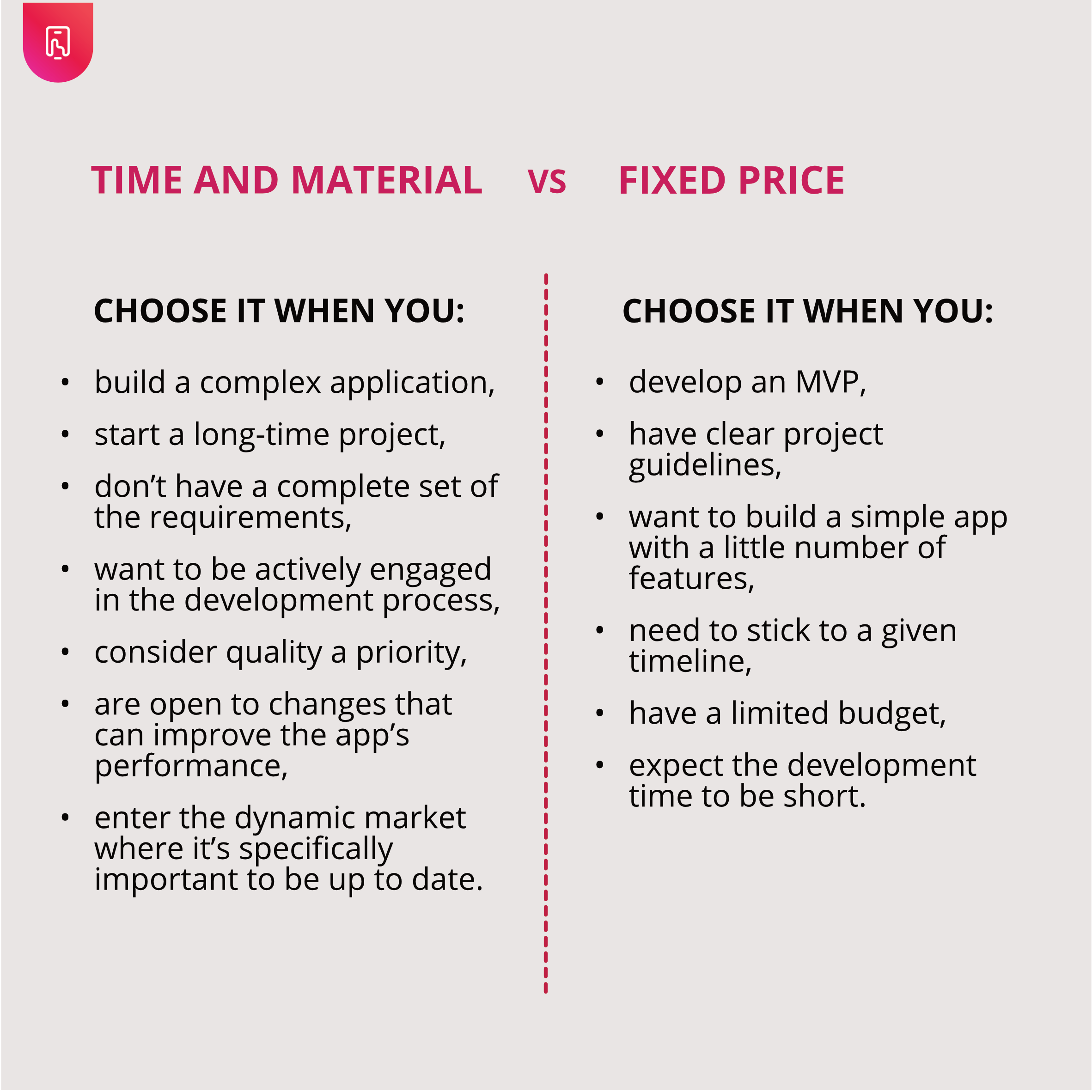Time and Materials vs Fixed Price – Overview of Pros and Cons that will Help You Choose the Right Billing Model

When you call a software development company and ask what pricing models they offer, there are usually two answers – fixed price and time & materials.
In most cases, you’ll be recommended to choose the T&M agreement. And it’s likely that it will work for you.
But let’s face it – the billing model has an impact not just on the budget but directly on the success of the product. You need to know exactly what are the pros and cons of both contracts to choose the right option for your software development.
Key takeaways
- When choosing a software development company, there are typically two pricing models to consider: fixed price and time & materials contract.
- The time and material billing model involves paying for the hours the team spends on development, including the cost of necessary resources.
- The fixed price model sets the cost from the start based on a detailed project scope.
- With a fixed price, there is no risk of exceeding the budget. However, there is less flexibility in reacting to changes, which can result in additional expenses and potential performance issues.
- With the time and materials contract, the product owner receives regular updates on costs and is actively involved in the development process.
What is the time and materials pricing model?
In the time and materials contracts, you pay for the hours the team spends on the software development. The price includes also the cost of the resources needed to build the application.
Choosing a time and material model is like going to a tailor to have a custom suit made. You know the estimated price, but you can’t predict whether you will gain or lose a pound or two as time goes by. And if something like that will occur, the tailor will have to adjust the suit – add new stitches or cut off a piece of fabric. This will impact the final cost of the service but you will get the clothing custom made for your needs.
The T&M contract in software development
Think of Adam, a product owner who wants to build an e-commerce application. If he chooses a T&M model, the software company estimates the entire cost of the project. Adam realizes that the final figures will most likely be different, but at least he knows what to expect.
On top of that, Adam regularly receives information on how much he needs to pay for the agreed development period.
Over the course of the development process, the software company is constantly in touch with Adam and discusses with him the next steps. This way he knows what the team will do in the following stage of the project, and how much time/money it takes.
The time and material billing model is the most popular one among software development companies – but it’s not the only option. For those who are looking for an alternative, there’s a fixed price agreement.
What is the fixed price billing model?
In the fixed price model, the cost of the mobile app development is set up from the start, based on the very detailed project scope.
If we stick to a clothing metaphor, signing a fixed price contract is more like choosing a ready-to-wear suit at the store and paying the given price. Even though the sleeves are a bit too clingy and the trousers could be a little shorter, there are no surprises waiting for you at the check-out.
The fixed price model in software development
Let’s get back to our fellow Adam. If he decides on a fixed price model, he will know the final cost of the application from day one. He can just schedule transfers and wait for the results. The entire backlog is already prepared, so he knows what exactly developers must do to complete the project – at least if everything goes according to plan.
Pros and cons – overview

Fixed price – advantages
No risk of exceeding the budget
There’s no need to worry that the mobile app development will cost more than expected. With a fixed price contract, you can be sure that you will get the product with no additional expenses. Unless you decide to do something out of scope, of course.
Less client’s engagement
When everything is planned and nicely documented, management is much easier. Thus, a product owner doesn’t have to actively participate in the development process. All the decisions have been made, so the rest in the team’s hands.
More control over the timeline
In this pricing model, the whole plan for the development is set up ahead. You know when the deadlines are coming, and at what stage the process should be at a given time. You can be sure that the product will get to the market right when you want to.
Fixed price – cons and problematic issues
No flexibility in reaction to changes
Let’s say the competition added a new feature, and you need a similar solution if you want the app to succeed. Or maybe it turns out that you can’t provide the data needed to build some functions, so the development team must come up with another way to achieve the goal.
We can go on and on like this, but the conclusion is simple – you cannot always predict changes, especially in long-term projects. The more complex the app is, the harder it gets.
Changes often mean more expenses as you have to create solutions that haven’t been included in a project scope. There’s also a risk of possible performance issues – that’s the case if the team only chooses from the options that can be developed in an agreed time and budget.
No room for optimization
In the Agile approach – recommended in software development – the team regularly meets, exchanges insights, and constantly optimizes the application. With a fixed price contracts, there’s no point in discussing new ideas because you can’t go beyond the scope, anyway. Quality is not considered a priority, so to speak.
Truth be told, no matter how meticulously you prepare for the entire project – the perspective shifts when you see the working product.
If you stick to the first plan at any cost, you miss the opportunities that could boost your business growth.
Time-consuming preparations
Creating detailed documentation is not something you can do overnight. The software company that signed a fixed price contract must thoroughly think about every possible aspect of the project. And planning every element of the scope delays the development.
The risk of more expensive development
Sometimes, the cost of a project based on a fixed price contract is higher compared to the time and materials agreement. How so? The budget in the first model is set up with the assumption that something unexpected might come up and it would be impossible to stick to the plan. It’s better to be safe than sorry – it’s only natural that software companies want to be prepared for such a situation.
Who can benefit from a fixed price agreement?
In certain cases, fixed price contracts can have essential advantages over a T&M model.
You’d better examine a fixed price billing system when your company:
- develops an MVP – a simple app without advanced, complex functions,
- has clear project guidelines,
- wants to build a simple app with a little number of features,
- needs to stick to the given timeline,
- expects a short development time,
- don’t have a dedicated person that could be actively involved in the project.
Time and materials contract – advantages
Flexibility and more chances to create a marketable product
Clients can make changes to the scope when they find it beneficial to the project. Do you need to add a new feature? No problem. The technology you initially wanted to use cannot be implemented? We can try something different and adjust the backlog to current needs. Even the team is scalable – over the course of the development process we can increase or decrease the number of software engineers to optimize the work.
T&M is especially advantageous in long-term projects when it’s almost impossible to plan every action before the development starts.
We don’t need to stick to the initially selected solutions. Instead, we can discuss the project on the go and try out options that make the product more functional. This way we ensure a better user experience and build the in-demand products the market is waiting for.
Less time for preparations
The team doesn’t spend much time on documentation, so the software development starts sooner. There’s no point in completing the entire backlog before the beginning of the project – a Project Manager can add new elements on the go.
More control over the development process
You’re always kept in the loop and can have a real impact on the project. The development team regularly presents you with the results of their work and together you discuss the next steps. Yes, for a product owner this means more engagement, but the effort pays off. Close cooperation with the company helps you make decisions that result in a better product.
No additional costs
We’ve mentioned it before, but to be clear – in the time and material pricing model you pay for hours of work and the resources. There are no additional costs, like in a fixed price model when you pay for a possibility that something might go wrong.
T&M – cons and problematic issues
Chance that the final price would be higher than estimated
With a fixed price you know exactly what budget you need to have. If you choose a time and materials contract, it’s not so predictable – you get the estimation, so you know what to expect, but you don’t know the exact final figures.
On the flip side, T&M allows you to control the entire process. All actions are consulted beforehand – there’s no risk that all of a sudden, you’ll need to pay more than expected. Rest assured, the development team won’t implement any solutions without your approval.
More engagement from product owner
Like we’ve pointed out before, a client follows the app development process and becomes an active member of the team. A product owner needs to take some time for this.
Hard to plan the entire timeline
You can’t have your cake and eat it, too. Either you have total control over the timeline, or you make adjustments in a flexible development process. Only in the latter case, you need to know that the final release date is hard to plan from the start.
Who can benefit from a T&M agreement?
When comparing fixed price vs time and materials models, the latter usually is especially recommended when you:
- build a complex application,
- start a long-time project,
- don’t have all the requirements figured out,
- are open to changes that can improve the app,
- enter the dynamic market where it’s specifically important to be up to date.
Time and materials contract vs fixed price in software development – summary
There is no one-size-fits-all option, here. Both billing models have pros and cons, but it’s basically the choice between predictability (when the price is fixed) and flexibility (Time and Materials contract).
Mind, that it’s almost impossible to predict every element of the big, long-term projects, and even with smaller ones it can be tricky.

Need more help choosing the type of contract? Contact us and tell us about your project. We’ll review all the pros and cons and suggest the best option for your business.







